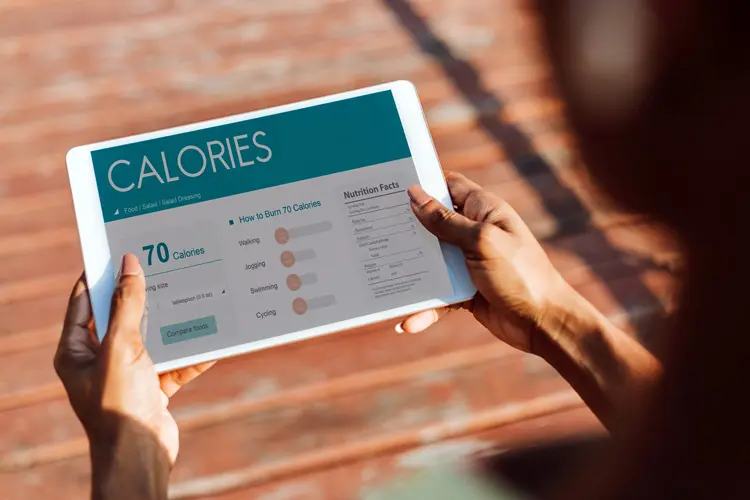As a personal trainer for over seven years, I have helped hundreds of people achieve their weight loss goals. At the same time, I see folks make the same mistake over and over while trying to lose weight.
Weight loss ultimately comes down to a calorie deficit, meaning you must expend more calories than you burn in a day.
Within a few weeks of adopting a calorie deficit, you may notice inches coming off your waist. However, most usually hit a weight loss plateau sooner rather than later.
There can be multiple reasons for a weight loss plateau, but among the most common is a lowered TDEE (Total Daily Energy Expenditure), known as adaptive thermogenesis. (1)
To continue your weight loss progress, you must lower your calorie intake slightly to counter the metabolic changes your body has undergone while maintaining a caloric deficit.
Weight loss plateaus can be incredibly frustrating. In this article, we go over how your TDEE changes and why adjusting calories is key to continued success.
Level Up Your Fitness: Join our 💪 strong community in Fitness Volt Newsletter. Get daily inspiration, expert-backed workouts, nutrition tips, the latest in strength sports, and the support you need to reach your goals. Subscribe for free!
Introduction to TDEE & Weight Loss Plateaus
Understanding TDEE can help you achieve consistent weight loss progress.
TDEE is the number of calories your body burns during a day to carry out essential bodily functions like digestion and physical activity like hitting the gym or taking the dog for a walk. Total Daily Energy Expenditure is measured in calories, a unit of energy.
I tell my clients to think of TDEE as their baseline daily energy budget.
An individual must consume fewer calories than their daily TDEE value to lose weight. Conversely, eating more calories than they expend will result in weight gain. If your calorie intake is the same as your TDEE, your body weight will remain the same.
Weight Loss Plateaus
Our bodies are incredibly adaptable. It is how the human race evolved and thrived over the centuries.
When you stick to a particular calorie range, your metabolism adjusts to make burning and storing energy more efficient. For example, if you were at a 500 daily calorie deficit, you might see results for the first four to eight weeks, but it will eventually slow down before halting completely.
You must consistently adjust your diet and calorie intake to ensure the numbers on the scale tick down steadily.
Understanding TDEE and Its Role in Weight Management
TDEE has four components that make it so reliable. These include:
- Basal Metabolic Rate (BMR): It is the number of calories you need for the most basic body functions like breathing and digestion. It depends on factors like age, gender, weight, and height.
- Exercise Activity Thermogenesis (EAT): These are the calories burned during structured training programs. HIIT workouts burn more calories than LISS training sessions.
- Non-Exercise Activity Thermogenesis (NEAT): This involves calories burned throughout the day during non-exercise activities like lawn mowing or washing dishes.
- Thermic Effect of Food (TEF): Eating and digesting food also requires energy. TEF leads to an increase in the metabolic rate after eating a meal. Notably, protein-rich foods have a higher thermic effect than high-carb or fat foods.
How To Measure Your TDEE
There are two main ways to measure your TDEE:
TDEE Calculator
Doing the TDEE calculations manually can be very tedious. Use our online calculator to know how many calories you should be eating in a day to achieve your goal weight:
My TDEE Stats:
Download your PDF Report
Please enter your full name
Your Maintenance Calories
calories per day
calories per week
| Basal Metabolic Rate | calculated calories per day |
| Sedentary | calculated calories per day |
| Light Exercise | calculated calories per day |
| Moderate Exercise | calculated calories per day |
| Heavy Exercise | calculated calories per day |
| Athlete | calculated calories per day |
Ideal Weight: calculated
| G.J. Hamwi Formula (1964) | calculated |
| B.J. Devine Formula (1974) | calculated |
| J.D. Robinson Formula (1983) | calculated |
| D.R. Miller Formula (1983) | calculated |
BMI Score: calculated
| 18.5 or less | Underweight |
| 18.5 – 24.99 | Normal Weight |
| 25 – 29.99 | Overweight |
| 30+ | Obese |
Maximum Muscular Potential
Macronutrients
protein
fats
carbs
protein
fats
carbs
protein
fats
carbs
protein
fats
carbs
protein
fats
carbs
protein
fats
carbs
protein
fats
carbs
protein
fats
carbs
protein
fats
carbs
Remember, TDEE is a rough estimation of your daily caloric needs and can vary for each individual, depending on their metabolism, body composition, and even daily activity variations.
Learn more about calculating TDEE in our in-depth guide here!
Activity Trackers
Most wearable fitness trackers can track your daily calorie burn.
I recommend investing in one of these activity trackers if you are serious about your progress. Remember, you don’t have to buy the latest Apple Watch. You can start with an entry-level tracker with a built-in accelerometer and heart rate monitor.
Wear the activity tracked for at least a week, and you’ll have a solid sense of the number of calories you burn daily. The average calories burned in a week will be your baseline TDEE.
Factors Affecting TDEE
TDEE isn’t a static health marker and depends on multiple factors, including:
- Age: Older people usually have a slower metabolism, which results in a lower TDEE.
- Gender: Men generally have a higher TDEE than females because of the male sex hormone testosterone.
- Height and Weight: Lighter individuals have a lower TDEE than their larger-bodied counterparts.
- Activity Levels: People who are physically active throughout the day burn more calories than sedentary folks.
- Muscle Mass: Muscular people burn more calories throughout the day as muscle mass is more metabolically active than fat mass.
- Genetics: Your metabolic rate is also influenced by your genetics. People with a faster metabolic rate burn more calories than those with a slower metabolism.
- Health Conditions: Certain medical conditions like hypothyroidism can slow down your metabolism. In contrast, some conditions can boost your metabolic rate.
- Stress: Cortisol can lower your metabolism and TDEE. (2)
Avoid comparing your TDEE to other people. Your TDEE will be unique to you, and you must adjust your calorie intake accordingly to meet your fitness objectives.
How To Avoid Weight Loss Plateaus
Once you have the TDEE value, here’s what you must do to avoid hitting weight loss plateaus:
Track Your Progress
I have my clients weigh themselves at a particular time each week to ensure a reliable reading. I recommend weighing yourself each Monday morning on an empty stomach after using the loo.
You must also record other metrics like waist, arm, and thigh circumference using a tape measure and take progress pictures in the same spot and lighting. Also, pay close attention to how your clothes fit. Is your shirt a bit looser? This gives you enough data points to assess your progress tangibly.
Sometimes, you might not see the scale’s needle budge, but you might lose inches off your belly. This is known as body recomposition.
Make Consistent Adjustments
Once you have the data, it’s time to make the necessary adjustments based on the results.
Increase the calorie deficit if you don’t see the desired progress. On the flip side, you can stick with your existing TDEE and calorie intake goals if you are on the right path.
Since there are several variables involved here, I recommend beginners work with a professional to ensure safety and optimal results.
Identifying and Overcoming Weight Loss Plateaus
Losing weight requires a ton of patience, hard work, and persistence.
However, there is still no guarantee that everything will go as planned. Most people hit a weight loss plateau before achieving their transformation objective. When the scale’s needle refuses to move, it is a sign to change gears.
Understanding the reason behind these weight loss plateaus can equip you to handle them better.
Here are some of the most common reasons for hitting a weight loss plateau:
Metabolic Adaptations
Metabolism is the process by which your body turns food into energy.
Like TDEE, metabolism depends on multiple factors such as age, gender, height, and weight. Heavier individuals usually have a faster metabolism as they need more fuel to power their activities.
When you begin losing weight, your metabolic rate usually slows down as you don’t need as much energy to carry on your daily activities as before.
Metabolic adaptation is among the biggest reasons why most people cease to lose weight after a certain point.
Level Up Your Fitness: Join our 💪 strong community in Fitness Volt Newsletter. Get daily inspiration, expert-backed workouts, nutrition tips, the latest in strength sports, and the support you need to reach your goals. Subscribe for free!
Muscle Gain
People following a resistance training plan while on a weight loss program might hit a weight loss plateau.
Why is that, you ask?
Well, muscle mass is about 18 percent denser than fat mass. Even if the muscle mass you gain is less than the fat you shed, your overall weight will likely stay consistent. I encourage my clients to stick to one goal at a time for faster results.
Understanding Calorie Intake
Many people are stringent about their weight loss diet initially but loosen up 8-10 weeks into the program.
Remember, every small bite you take will matter as you progress toward your weight loss goal, especially when your body has started adjusting to your new diet regime. Small miscalculations will add up as your calories shrink. The margin of error is super small when you are on a plateau.
Pro Tip: Letting yourself lose during a weight loss plateau can be disastrous. You must prioritize achieving a breakthrough when you’ve hit an overhead ceiling.
Water Retention
Weight loss can be complicated, as it depends on many factors, including water retention.
Stress levels, sodium intake, and hormonal fluctuation can also cause temporary water weight fluctuations. Consuming excessive amounts of sodium-rich foods can lead to bloating. Many competitive bodybuilders manipulate water and use diuretics to shed water weight and reveal muscle conditioning and striations before stepping on stage.
That said, this is a very risky proposition and shouldn’t be attempted by most individuals.
Holding onto water might make you feel like you’ve hit a plateau, even when you are losing fat weight.
How To Know if You Have Hit a Weight Loss Plateau
Weight loss is not linear. You shouldn’t expect to lose the same amount of weight each week until you hit your objective. There might be weeks where you gain 1-2 pounds instead of shedding them.
In my experience working as a personal trainer, I’ve noticed many individuals prematurely conclude they’ve hit a weight-loss plateau, even when it’s not the case.
Here are two ways to tell if you’ve actually hit a weight loss plateau:
Time Frame
It’s no cause for concern if your weight has not changed in a week.
Depending on the amount of weight you want to lose and your current fitness levels, your body might readjust its metabolism somewhere in the middle of your weight loss program. Furthermore, we don’t live in a vacuum, and occasions arise when we must eat out with friends and family during our physique transformation.
One or two such meals can put your weight loss progress on a halt.
That said, if your body weight and measurements stay stagnant for two to three weeks despite following your weight loss program to the T, it might not be a minor blip but a weight loss plateau.
Periods For Women
Menstruating women experience hormonal shifts each month, which can cause bloating. A weight gain during this period is usually due to water retention and is, hence, temporary.
Women should avoid weighing themselves or taking body measurements while they’re on their period.
Strategies for Adjusting Calorie Intake Based on TDEE
Follow these steps to adjust your calories to break through weight loss plateaus:
Recalculate Your TDEE
As you might know by now, TDEE is ever-evolving. If you have hit a weight loss plateau, it might be time to reassess your TDEE and reset your calorie target.
In a TDEE calculator, input your latest measurements to determine your new calorie intake targets. I recommend my clients recalculate their TDEE after every 10 pounds of weight loss (or gain).
Remember, failing to recalculate your TDEE can stall or even derail your progress. Be nimble-footed to avoid weight loss plateaus.
How many calories should you cut?
Many make the mistake of cutting too many calories from their daily intake while trying to lose weight. This can lead to nutritional deficiencies, resulting in chronic health conditions.
Per the Centers for Disease Control and Prevention (CDC), you can cut 500 to 1,000 calories daily from your diet to safely lose 1 to 2 pounds weekly. Stay within this range to ensure your weight loss is gradual and sustainable. (3)
After you’ve hit a weight loss plateau, don’t deduct another 500 to 1,00 calories from your daily quota. Instead, use smaller 100- to 200-calorie adjustments until you start seeing the needle move in the right direction.
As explained in the previous section, give your body another two to three weeks before cutting 100 to 200 calories more.
Increase Physical Activity
Getting more physically active is one of the most effective ways of losing weight.
Don’t limit physical activity to a one-hour gym session. Remember, NEAT is as vital as EAT. I recommend walking 500 to 1,000 steps every two hours throughout the day. This will ensure you’re consistently burning calories, and it is also a great way to hit the coveted 10,000 steps a day target.
Pro Tip: Think about how you can incorporate more physical activity into your day. Take the stairs instead of the elevator or bike to the office instead of using the car.
Prioritize Sleep
In contrast to popular opinion, you don’t shed weight when you are exercising. You lose weight while you’re sleeping.
You must allow your body at least seven to eight hours of sleep each night to ensure optimal metabolism and hormone levels.
Remember, pushing your body too hard on a sleep debt does more harm than good. Feel free to take a day off from training if you feel you’re not properly rested. However, don’t use this as an excuse to skip workouts.
Patience and Setting Realistic Expectations
Losing weight sustainably requires time, dedication, patience, persistence, and commitment.
That said, you must also begin with a realistic goal. Starting with an audacious goal might be motivating initially, but the enthusiasm wanes quickly. This is also why most people quit before achieving their fitness goals.
Work with a fitness professional to assess what a realistic goal for you might look like and then develop a personalized program to achieve it.
Conclusion
Contrary to what most people think, your weight loss journey isn’t always a linear path.
You might hit several plateaus and roadblocks along the way. However, you must not get discouraged by these. Consider them a part of the journey.
Understanding your TDEE and adjusting your calories will help you unlock continued progress.
TDEE is the amount of calories your body needs for essential bodily functions and daily activities. A weight loss plateau is hit when the body adjusts its TDEE according to your new calorie intake goals. You must consistently assess and tweak your calorie intake to achieve your physique goals.
Do you have any questions about TDEE or weight loss? Drop them in the comments below, and I’ll be happy to help!
References
- Sarwan G, Rehman A. Management of Weight Loss Plateau. [Updated 2022 Oct 24]. In: StatPearls [Internet]. Treasure Island (FL): StatPearls Publishing; 2024 Jan-. Available from: https://www.ncbi.nlm.nih.gov/books/NBK576400/
- Kuo, W. C., Bratzke, L. C., Oakley, L. D., Kuo, F., Wang, H., & Brown, R. L. (2019). The association between psychological stress and metabolic syndrome: A systematic review and meta-analysis. Obesity reviews: an official journal of the International Association for the Study of Obesity, 20(11), 1651–1664. https://doi.org/10.1111/obr.12915
- Centers for Disease Control and Prevention (CDC). (2024, February 28). Losing Weight. Retrieved from https://www.cdc.gov/healthyweight/losing_weight/












